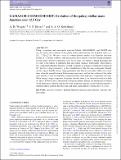Files in this item
GAMA/G10-COSMOS/3D-HST : evolution of the galaxy stellar mass function over 12.5 Gyr
Item metadata
| dc.contributor.author | Wright, A. H. | |
| dc.contributor.author | Driver, S. P. | |
| dc.contributor.author | Robotham, A. S. G. | |
| dc.date.accessioned | 2018-11-02T13:30:07Z | |
| dc.date.available | 2018-11-02T13:30:07Z | |
| dc.date.issued | 2018-11-01 | |
| dc.identifier | 256434826 | |
| dc.identifier | e8facbf9-0155-41d6-a431-4d2ff01293ef | |
| dc.identifier | 85055157704 | |
| dc.identifier | 000449616200048 | |
| dc.identifier.citation | Wright , A H , Driver , S P & Robotham , A S G 2018 , ' GAMA/G10-COSMOS/3D-HST : evolution of the galaxy stellar mass function over 12.5 Gyr ' , Monthly Notices of the Royal Astronomical Society , vol. 480 , no. 3 , pp. 3491-3502 . https://doi.org/10.1093/MNRAS/STY2136 | en |
| dc.identifier.issn | 0035-8711 | |
| dc.identifier.uri | https://hdl.handle.net/10023/16384 | |
| dc.description.abstract | Using a combined and consistently analysed GAMA, G10-COSMOS, and 3D-HST data set, we explore the evolution of the galaxy stellar mass function over lookback times tL ∈ [0.2, 12.5] h70-1 Gyr. We use a series of volume-limited samples to fit Schechter functions in bins of ~constant lookback time and explore the evolution of the best-fitting parameters in both single and two-component cases. In all cases, we employ a fitting procedure that is robust to the effects of Eddington bias and sample variance. Surprisingly, when fitting a two-component Schechter function, we find essentially no evidence of temporal evolution in M*, the two α slope parameters, or the normalization of the low-mass component. Instead, our fits suggest that the various shape parameters have been exceptionally stable over cosmic time, as has the normalization of the low-mass component, and that the evolution of the stellar mass function is well described by a simple build-up of the high-mass component over time. When fitting a single component Schechter function, there is an observed evolution in both M* and α however, this is interpreted as being an artefact. Finally, we find that the evolution of the stellar mass function, and the observed stellar mass density, can be well described by a simple model of constant growth in the high-mass source density over the last 11 h70-1 Gyr. | |
| dc.format.extent | 12 | |
| dc.format.extent | 5720068 | |
| dc.language.iso | eng | |
| dc.relation.ispartof | Monthly Notices of the Royal Astronomical Society | en |
| dc.subject | Galaxies: evolution | en |
| dc.subject | Galaxies: luminosity function | en |
| dc.subject | Galaxies: stellar content | en |
| dc.subject | Mass function | en |
| dc.subject | QB Astronomy | en |
| dc.subject | Astronomy and Astrophysics | en |
| dc.subject | Space and Planetary Science | en |
| dc.subject | 3rd-DAS | en |
| dc.subject.lcc | QB | en |
| dc.title | GAMA/G10-COSMOS/3D-HST : evolution of the galaxy stellar mass function over 12.5 Gyr | en |
| dc.type | Journal article | en |
| dc.contributor.institution | University of St Andrews. School of Physics and Astronomy | en |
| dc.identifier.doi | https://doi.org/10.1093/MNRAS/STY2136 | |
| dc.description.status | Peer reviewed | en |
This item appears in the following Collection(s)
Items in the St Andrews Research Repository are protected by copyright, with all rights reserved, unless otherwise indicated.

